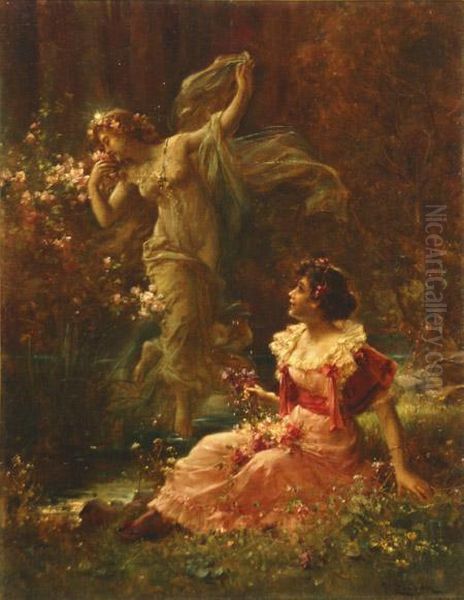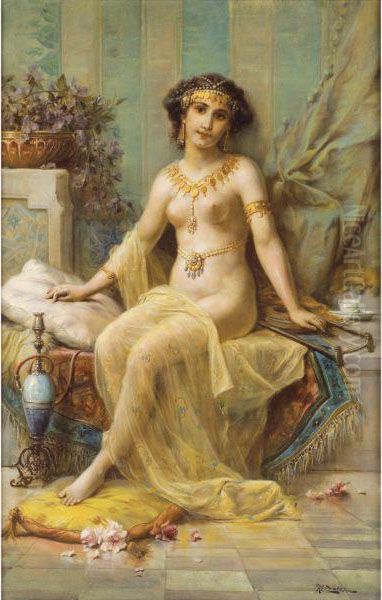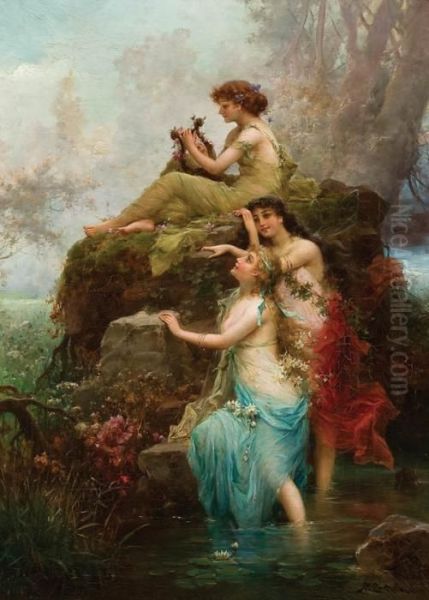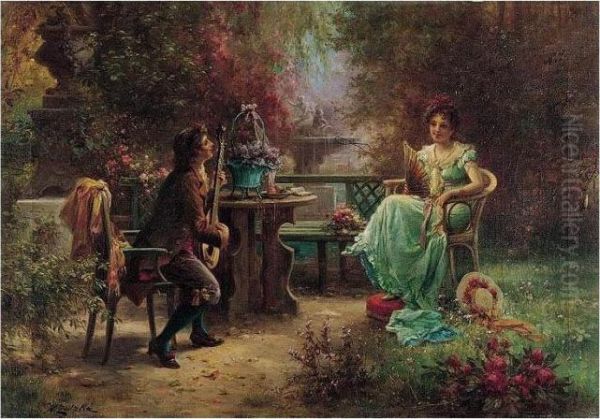Hans Zatzka stands as a fascinating figure in late 19th and early 20th-century European art. An Austrian painter, he carved a unique niche for himself with his enchanting depictions of idealized female figures, mythological scenes, cherubic cupids, and serene allegories. While perhaps not always at the forefront of avant-garde movements of his time, Zatzka's work resonated deeply with a public captivated by beauty, romance, and escapism. His prolific output, often disseminated through popular prints and postcards, made his imagery ubiquitous and cemented his status as a beloved, if sometimes commercially driven, artist of his era.
Early Life and Artistic Formation in Vienna
Hans Zatzka was born on March 8, 1859, in Breitensee, which is now part of Vienna, Austria. His father, Bartholomäus Zatzka, was a building contractor or carpenter, and his mother was Marie Karpischek Zatzka. From a young age, Zatzka exhibited a clear proclivity for the arts. This nascent talent was nurtured, and he embarked on a formal artistic education that would shape his technical proficiency and aesthetic sensibilities.
Between 1877 and 1882, Zatzka was enrolled at the prestigious Academy of Fine Arts in Vienna (Akademie der bildenden Künste Wien). This institution was a bastion of academic tradition, emphasizing rigorous training in drawing, anatomy, and classical principles. During his studies, Zatzka had the opportunity to learn from several notable professors who were respected figures in the Viennese art world. Among his instructors were Carl von Blaas, a history painter known for his frescoes and portraits, Christian Griepenkerl, a conservative academic painter who famously rejected Adolf Hitler's application to the Academy, and Carl Wurzinger. Some accounts also mention Ludwig Karl Strauch and Karl Mayer von Mayerfels as influential teachers. Under their tutelage, Zatzka honed his skills in rendering the human form, mastering perspective, and developing a refined painting technique.

His dedication and talent did not go unnoticed. In 1880, while still a student, Zatzka was awarded the prestigious Golden Füger Medal for composition. This accolade was a significant recognition of his abilities and likely provided a considerable boost to his confidence and burgeoning career. The academic environment, with its focus on historical and mythological subjects, undoubtedly influenced Zatzka's thematic choices in his later work, even as he developed his own distinctive style.
The Budding Artist: Early Career, Influences, and Italian Sojourn
Upon completing his studies at the Academy in 1882, Hans Zatzka embarked on his professional career as an independent artist. His academic training equipped him well for various commissions. He undertook several study trips, including an important journey to Italy. Such trips were almost a rite of passage for aspiring artists of the period, allowing them to immerse themselves in the masterpieces of the Renaissance and Classical antiquity firsthand. In Italy, Zatzka would have studied the works of masters like Raphael, Titian, and Correggio, absorbing their approaches to color, composition, and the idealized human form. This experience likely further refined his appreciation for classical beauty and narrative clarity.
During his early career, Zatzka engaged in creating religious art and large-scale murals for churches and other public and private institutions. This work included altarpieces and ceiling frescoes, particularly in the Innsbruck area and various churches throughout Austria. These commissions required not only artistic skill but also an understanding of iconographic traditions and the ability to work on a grand scale. This experience with decorative and religious painting would inform the sensibility of his later, more famous easel paintings.
Beyond the classical and academic traditions, Zatzka's artistic imagination was significantly fired by other cultural currents. He was deeply influenced by the operas of Richard Wagner, whose epic tales of mythology, romance, and heroism captivated Europe. The dramatic intensity and romantic idealism of Wagner's works found a visual echo in Zatzka's paintings. Similarly, the enchanting world of Grimm's Fairy Tales provided a rich source of inspiration, with their blend of folklore, fantasy, and moral allegory. These influences steered Zatzka towards subjects that were often whimsical, idyllic, and imbued with a sense of wonder.
Artistic Style and Thematic Focus: The Realm of Idealized Beauty
Hans Zatzka's mature artistic style is characterized by a meticulous technique, vibrant yet harmonious color palettes, and a distinct preference for idealized and romantic subjects. He became particularly renowned for his depictions of graceful young women, often portrayed as nymphs, fairies, allegorical figures, or simply as embodiments of feminine beauty and innocence. These figures are typically set in lush, idyllic landscapes, surrounded by flowers, cherubic putti, or mythological companions.

His brushwork is smooth and polished, leaving little trace of the artist's hand, a hallmark of the academic tradition he inherited from painters like his teacher Carl von Blaas or French academic masters such as William-Adolphe Bouguereau and Jean-Léon Gérôme. Zatzka paid great attention to detail, rendering fabrics, flowers, and flesh tones with remarkable precision. His compositions are generally well-balanced and harmonious, designed to please the eye and evoke a sense of tranquility or gentle sentimentality.
Thematically, Zatzka's oeuvre revolves around several key areas:
Mythological and Allegorical Scenes: He frequently painted subjects from classical mythology, such as Venus and Cupid, Diana the huntress, or various nymphs and satyrs. Allegories of spring, love, music, and the arts were also common, often personified by beautiful female figures.
Romantic and Genre Scenes: Many of his works depict charming genre scenes, often with a romantic or sentimental undertone. These might include young lovers, women in gardens, or playful interactions with cherubs.
Religious Subjects: While his fantasy paintings are more widely known today, Zatzka continued to produce religious art throughout his career, including depictions of Madonnas, saints, and guardian angels. These works, though devotional, often share the same gentle, idealized aesthetic as his secular pieces.
Orientalist Themes: Like many artists of his time, such as Jean-Auguste-Dominique Ingres or later, Ludwig Deutsch, Zatzka occasionally ventured into Orientalist subjects, depicting harem scenes or exotic beauties, though these were less central to his output.
His portrayal of women is particularly noteworthy. Zatzka's female figures are almost invariably youthful, beautiful, and imbued with an air of innocence and grace. They conform to a specific ideal of feminine beauty prevalent in the late 19th century, often characterized by delicate features, flowing hair, and serene expressions. This idealization, while perhaps not reflecting the complexities of real women, contributed significantly to the popular appeal of his art.
The Master of Pseudonyms: Navigating the Art Market
One of the most intriguing aspects of Hans Zatzka's career was his extensive use of pseudonyms. It is known that he signed his works with a variety of names other than his own. Among the most frequently cited are P. Ronsard (or Pierre de Ronsard, an homage to the French Renaissance poet), H. Zabateri, Joseph Bernard, Bernard Zatzka, and J. Bernard. Some sources also list names like P. R. Sonders.

The primary reason for this practice was commercial. Zatzka had contractual agreements with art dealers and publishers that often stipulated exclusivity or limited the number of paintings he could sell under his own name. By using pseudonyms, he could bypass these restrictions and produce a larger volume of work for different clients without violating his existing contracts. This allowed him to maximize his income and cater to the considerable demand for his popular style of painting.
This use of multiple names, however, has created considerable confusion for art historians and collectors over the years. Attributing works correctly can be challenging, and it has sometimes led to his paintings being misattributed or to the erroneous creation of separate artistic identities in art databases. Despite these complications, the practice underscores Zatzka's business acumen and his prolific nature as an artist responding to market demands. It also highlights the commercial realities faced by many artists who sought to make a living from their craft in a competitive environment.
Commercial Success and Popular Appeal in the Age of Reproduction
Hans Zatzka achieved considerable commercial success during his lifetime, largely due to the widespread reproduction of his paintings. In the late 19th and early 20th centuries, advancements in printing technology made it possible to mass-produce high-quality color reproductions of artworks. Zatzka's charming and accessible imagery was perfectly suited for this market.
His paintings were extensively reproduced as picture postcards, calendar illustrations, and decorative prints. These reproductions found their way into countless middle-class homes across Europe and America, making Zatzka's art a familiar part of the popular visual culture of the era. The themes of love, innocence, beauty, and gentle fantasy resonated with a broad audience seeking pleasant and uplifting imagery. His depictions of cherubic children, graceful maidens, and idyllic scenes offered an escape from the rapid industrialization and social changes of the period.
This popular appeal meant that Zatzka's original paintings were also in demand. He sold his works through various dealers and galleries, and his style became a recognizable component of the decorative arts of the early 20th century. While he may not have been celebrated by the avant-garde critics who championed emerging movements like Impressionism, Post-Impressionism, or later, Cubism and Expressionism (think of his Austrian contemporaries Gustav Klimt or Egon Schiele, who pursued vastly different artistic paths), Zatzka enjoyed a sustained popularity with the general public. His success in the commercial art market is a testament to his ability to connect with popular taste and to create images that had broad appeal.
Representative Masterpieces: Visions of Grace and Fantasy

While Hans Zatzka was incredibly prolific, several works stand out as particularly representative of his style and thematic concerns:
"The Guardian Angel" (Der Schutzengel): This is one of his most famous religious-themed works. It typically depicts a benevolent angel watching over or guiding children, often in a perilous situation. The imagery is tender and reassuring, embodying themes of divine protection and innocence. The soft lighting and idealized figures are characteristic of Zatzka's approach.
"Allegory of Spring" (Frühlingsallegorie) / "Spring's Awakening": Zatzka painted numerous allegories of the seasons, with Spring being a favorite. These works often feature beautiful young women adorned with flowers, surrounded by cherubs and lush, blooming landscapes. They celebrate renewal, youth, and the beauty of nature, rendered with vibrant colors and delicate details.
"Venus and Cupid" (Venus und Amor): A classic mythological subject, Zatzka's interpretations often show the goddess of love in a serene, idyllic setting, accompanied by her mischievous son, Cupid. These paintings emphasize beauty, tenderness, and romantic love, avoiding the more dramatic or erotic interpretations found in the work of some other artists like Titian or later, François Boucher.
"Alpine Flowers" (Alpenblumen) / "Spring in the Alps": Reflecting his Austrian heritage, Zatzka sometimes depicted scenes with an Alpine backdrop. These paintings might feature young women gathering wildflowers in mountain meadows, combining his love for idealized femininity with the picturesque beauty of the Austrian landscape.
"Harem Beauty" or "Odalisque" type paintings: Though less common, Zatzka did produce works in the Orientalist vein, depicting reclining odalisques or scenes within a harem. These paintings, influenced by artists like Jean-Léon Gérôme or Ingres's famous "La Grande Odalisque," catered to the European fascination with the exotic East, often emphasizing sensuality and opulence.
"Nymphs and Satyrs" (Nymphen und Satyrn): These mythological scenes allowed Zatzka to explore playful and sometimes mildly erotic themes, with graceful nymphs interacting with mischievous satyrs in woodland settings. These works often have a lighthearted, pastoral quality.
Many of his other works, often untitled or known by generic descriptions like "A Young Beauty with Flowers" or "Cherubs at Play," consistently showcase his signature style: technically polished, charmingly sentimental, and dedicated to an aesthetic of idealized beauty.
Zatzka in the Context of His Time: Academicism and Popular Art
To fully appreciate Hans Zatzka's position, it's essential to view him within the broader artistic landscape of the late 19th and early 20th centuries. He was fundamentally an academic painter, adhering to the principles of representational accuracy, smooth finish, and elevated subject matter that characterized the official art academies of Europe. In this, he shared common ground with many highly successful artists of his era.
In France, painters like William-Adolphe Bouguereau and Alexandre Cabanel achieved immense fame and fortune with their polished mythological and allegorical canvases. In England, artists such as Lord Frederic Leighton and Sir Lawrence Alma-Tadema created meticulously detailed scenes from classical antiquity that were hugely popular with Victorian audiences. Zatzka's work, with its emphasis on idealized beauty and charming narratives, aligns with this broader academic tradition. His teacher, Carl von Blaas, was himself a product of this system.
However, Zatzka's art also tapped into a more popular, sentimental vein. His focus on easily understandable themes, his charming depictions of women and children, and the sheer prettiness of his paintings made them accessible to a wider public than some of the more intellectually demanding works of his academic peers. In this sense, his work can be compared to that of other artists who specialized in genre scenes or sentimental subjects, whose art was widely disseminated through prints.
While Zatzka was working, Vienna itself was a hotbed of artistic innovation. The Vienna Secession, founded in 1897 by artists like Gustav Klimt, Koloman Moser, and Josef Hoffmann, sought to break away from the conservative historicism of the official art institutions. Their work, which embraced Art Nouveau (Jugendstil) and Symbolism, was radically different from Zatzka's more traditional style. Artists like Egon Schiele and Oskar Kokoschka would soon push Viennese art into the realm of Expressionism. Zatzka, however, remained largely untouched by these avant-garde movements, continuing to paint in the style that had brought him success.
His mythological and fantasy themes also connect him to Symbolist painters like Arnold Böcklin (Swiss-German) or Franz von Stuck (German), who also explored dreamlike worlds and mythological narratives, though often with a darker or more psychologically charged atmosphere than Zatzka's generally cheerful and idyllic visions. Even the Pre-Raphaelite Brotherhood in England, with artists like John William Waterhouse (though later, he shared some of their romanticism), explored themes of myth and legend with a detailed, narrative style. Zatzka's work, however, generally lacked the complex symbolism or medievalism of the Pre-Raphaelites, opting for a more straightforwardly decorative and pleasing aesthetic. The decorative qualities of his work, particularly in his floral motifs and graceful figures, also bear a superficial resemblance to some aspects of Art Nouveau, as seen in the works of Alphonse Mucha, though Zatzka's style remained more rooted in academic realism.
Later Years, Death, and Enduring Legacy
Hans Zatzka lived a long and productive life, continuing to paint well into his later years. He remained in Vienna, witnessing the immense political and social upheavals of the early 20th century, including two World Wars and the collapse of the Austro-Hungarian Empire. Despite these turbulent times, his artistic focus remained largely consistent, providing a steady stream of charming and idyllic images.
He reportedly never took on students, preferring to focus on his own prolific output. His dedication to his craft was unwavering. Hans Zatzka passed away on December 17, 1945 (some sources state 1949, but 1945 is more commonly cited), in Vienna, at the age of 86.
In the decades following his death, Zatzka's work, like that of many academic and salon painters of his generation, was somewhat overshadowed by the critical acclaim afforded to modernist movements. However, there has been a renewed appreciation for academic and popular art of the late 19th and early 20th centuries in more recent times. Collectors and art enthusiasts have rediscovered the charm and technical skill evident in Zatzka's paintings.
Today, his original works appear regularly at auctions and are sought after by collectors who appreciate his particular brand of romantic fantasy. The numerous reproductions of his paintings continue to circulate, ensuring that his imagery remains familiar to many. While he may not be considered a revolutionary innovator in the grand narrative of art history, Hans Zatzka holds a secure place as a master of a specific genre – the idyllic and charming fantasy painting. His ability to create images of enduring popular appeal, coupled with his undeniable technical skill, marks him as a significant, if often underestimated, figure in the Austrian art scene of his time. His art serves as a delightful window into the tastes and sensibilities of an era that found solace and pleasure in idealized visions of beauty and romance.
Conclusion: The Lasting Allure of Zatzka's World
Hans Zatzka's artistic journey from the esteemed halls of the Vienna Academy of Fine Arts to the parlors of countless homes via popular reproductions is a testament to his skill and his understanding of public taste. He crafted a world filled with ethereal beauty, gentle sentiment, and playful fantasy, a world that offered an appealing counterpoint to the often harsh realities of his time. His dedication to a polished academic technique, combined with his imaginative interpretations of mythological, allegorical, and romantic themes, resulted in a body of work that continues to enchant.
While contemporary avant-garde movements in Vienna and beyond were charting new, often challenging, artistic territories, Zatzka remained committed to an aesthetic of charm and accessibility. His use of pseudonyms speaks to his pragmatic approach to the art market, while the enduring popularity of his images underscores their timeless appeal. As an art historian, one recognizes Hans Zatzka not for radical innovation, but for his mastery within his chosen domain, creating a legacy of delightful and beautifully rendered paintings that continue to bring pleasure to viewers today. He remains a beloved purveyor of dreams and idealized visions from a bygone era.